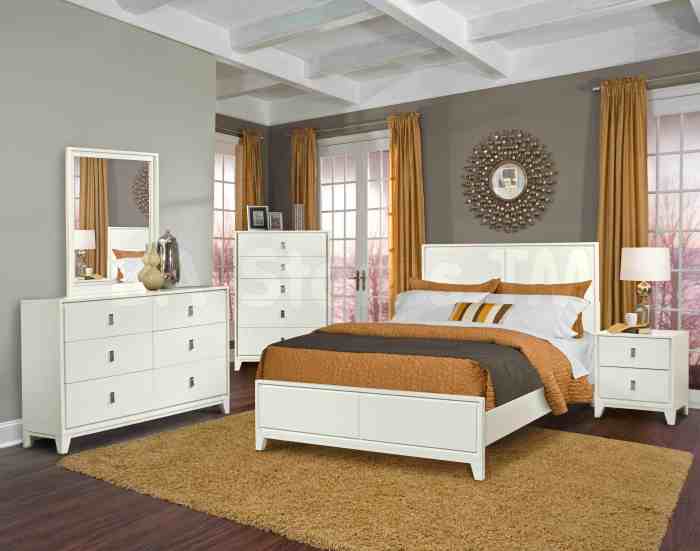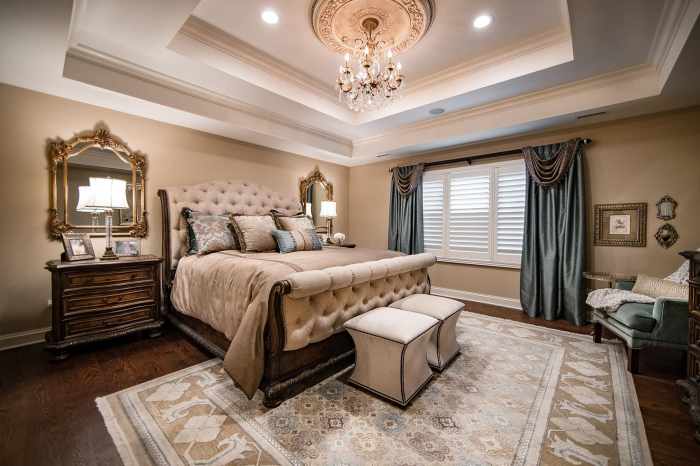Bedroom Styles and Trends

Bedroom design and furniture – Designing your bedroom is a deeply personal process, reflecting your individual style and needs. From calming minimalist havens to vibrant bohemian retreats, the options are vast. Understanding current trends and various design styles can help you create the perfect sanctuary. This section will explore popular bedroom styles, current design trends, and common layout considerations.
Bedroom Styles: A Visual Exploration
Creating a mood board is a fantastic way to visualize different design styles before committing to a specific aesthetic. Below, we will explore three distinct bedroom styles, outlining their color palettes and material choices. Imagine these as visual representations, each conveying a unique atmosphere.
Modern Minimalist: This style emphasizes clean lines, simplicity, and functionality. Imagine a predominantly white or light gray room, accented with muted blues or greens. Materials would include natural wood, sleek metal, and perhaps a touch of stone or concrete. Think a simple, low-profile bed frame, minimal nightstands, and ample storage solutions cleverly integrated into the design. The overall feel is calm, spacious, and uncluttered.
Bohemian: In stark contrast to minimalism, the bohemian style is characterized by eclecticism and warmth. Visualize rich textures and patterns: think layered rugs, woven tapestries, and intricate textiles in warm earthy tones like terracotta, ochre, and deep blues. Materials include natural fibers like jute, cotton, and wool, alongside vintage or repurposed furniture. The overall impression is cozy, layered, and expressive of personal style.
Creating a relaxing bedroom involves careful consideration of both furniture and design elements. The right bed, nightstands, and wardrobe are crucial, but equally important is the wall treatment. For inspiration on transforming your space, check out these bedroom wall design ideas with paint to find the perfect backdrop for your furniture. Ultimately, a cohesive approach to both furniture selection and wall design will result in a truly restful and personalized bedroom.
Traditional: Traditional bedrooms often evoke a sense of timeless elegance. Picture a room dominated by classic furniture pieces in dark wood, perhaps with upholstered headboards and ornate details. Color palettes usually include muted jewel tones such as deep greens, burgundy, or navy blue, often accented with gold or silver. Materials commonly include high-quality wood, luxurious fabrics like velvet or silk, and perhaps antique or vintage accessories.
The overall feel is sophisticated, refined, and enduring.
Current Trends in Bedroom Design, Bedroom design and furniture
Contemporary bedroom design is increasingly influenced by a focus on sustainability and smart home integration. Sustainable materials, such as bamboo, reclaimed wood, and organic cotton, are becoming increasingly popular, reflecting a growing awareness of environmental concerns. Smart home integration, on the other hand, allows for greater control and automation, enhancing convenience and energy efficiency. For example, smart lighting systems can create customized ambiance, while smart thermostats optimize temperature control, leading to potential energy savings.
Comparison of Popular Bedroom Layouts
Different bedroom layouts cater to diverse needs and space constraints. The following table compares and contrasts the pros and cons of master suites and smaller bedrooms.
| Feature | Master Suite | Smaller Bedroom |
|---|---|---|
| Space | Large, often including en-suite bathroom and walk-in closet. | Compact, often requiring efficient space planning. |
| Privacy | High level of privacy due to separate space. | Privacy may be less if located near other rooms. |
| Cost | Higher initial cost due to larger size and potential for luxury features. | Lower initial cost, but may require creative storage solutions. |
| Suitability | Ideal for couples or individuals desiring ample space and luxury. | Suitable for children, guests, or individuals with smaller living spaces. |
Incorporating Personal Touches and Decor
Transforming a bedroom from a simple sleeping space into a personal sanctuary involves thoughtfully incorporating elements that reflect your unique style and personality. This goes beyond simply choosing a color scheme; it’s about creating a space that feels authenticallyyou*. Adding personal touches not only enhances the aesthetic appeal but also fosters a sense of comfort and well-being.Personalizing your bedroom decor allows for the expression of individuality and the creation of a space that truly reflects your tastes and preferences.
By incorporating elements that resonate with you, you’ll cultivate a haven that promotes relaxation and rejuvenation. This section explores various ways to achieve this, focusing on personalized decor, the impact of textiles, and integrating personal hobbies into the design.
Personalized Decor Elements
Adding personalized decor elements significantly contributes to a bedroom’s character and warmth. These items act as visual reminders of cherished memories, hobbies, and passions, fostering a sense of comfort and familiarity within the space.
- Family Photos and Artwork: Displaying framed family photos or cherished artwork creates a warm and inviting atmosphere. Consider a gallery wall showcasing a collection of smaller prints or a single, large statement piece. A carefully curated selection can transform a plain wall into a personal narrative.
- Travel Souvenirs and Collectibles: Incorporating travel souvenirs or collectibles adds a unique touch and sparks conversation. Think about displaying a collection of miniature figurines on a shelf, hanging a tapestry acquired during a trip, or placing a small globe on a bedside table as a reminder of wanderlust.
- Personalized Throw Pillows and Blankets: Adding throw pillows and blankets with personalized embroidery, monograms, or unique patterns instantly elevates the bedroom’s aesthetic. These soft textiles offer both comfort and visual interest, reflecting individual style.
- Plants and Flowers: Introducing plants and flowers brings life and vibrancy into the bedroom. Whether it’s a lush potted plant or a simple vase of fresh flowers, greenery adds a touch of nature and creates a calming atmosphere. The choice of plants can be tailored to personal preferences, from low-maintenance succulents to vibrant flowering plants.
The Role of Textiles in Creating a Cohesive Atmosphere
Textiles play a crucial role in establishing a cohesive and inviting bedroom atmosphere. The careful selection of bedding, curtains, and rugs can significantly impact the overall feel of the room, contributing to its comfort and visual appeal.The right textiles can unify disparate elements and create a sense of harmony. For instance, coordinating the colors and patterns of bedding, curtains, and a rug can create a visually pleasing and balanced space.
The texture of the textiles also contributes to the overall ambiance; soft, plush materials promote a feeling of warmth and comfort, while crisp, linen textiles can create a more refined and sophisticated look. Consider the interplay of textures and colors to achieve the desired effect.
Bedroom Design Incorporating Personal Hobbies
Let’s imagine designing a bedroom for an avid reader and amateur photographer. The design would reflect these passions through careful selection of furniture and decor.The focal point could be a built-in bookshelf stretching along one wall, showcasing the owner’s extensive book collection. The shelves could be strategically lit to highlight the spines and create a warm, inviting glow.
On the opposite wall, a gallery wall could display a curated selection of the photographer’s best work, printed in high quality and presented in consistent frames. A comfortable reading nook with an armchair, a side table, and a floor lamp would provide a dedicated space for relaxation and enjoyment. The color palette might incorporate deep blues and greens, reminiscent of twilight skies and lush landscapes often captured in photography.
The overall style could be minimalist and modern, with clean lines and functional furniture, allowing the books and photographs to become the primary decorative elements. A large, plush rug would add warmth and comfort to the reading nook, tying the different elements together. The textiles, from the bedding to the curtains, could incorporate subtle patterns inspired by nature or abstract photography, maintaining a cohesive and personalized theme.
Budget-Friendly Bedroom Design

Creating a stylish and functional bedroom doesn’t require breaking the bank. With careful planning and a creative approach, you can achieve a beautiful and personalized space without compromising on quality or style. This section explores affordable materials, furniture options, and DIY techniques to help you transform your bedroom on a budget.
Affordable Materials and Furniture Options
Choosing cost-effective materials and furniture is crucial for budget-friendly bedroom design. Prioritizing durable, versatile options allows for flexibility and longevity, maximizing your investment.
- Secondhand Furniture: Thrift stores, consignment shops, and online marketplaces offer a treasure trove of affordable furniture. Look for solid wood pieces that can be refinished or repurposed. A sturdy, slightly worn wooden dresser can be revitalized with a fresh coat of paint and new knobs, transforming it into a unique focal point.
- Affordable Fabrics: Opt for budget-friendly fabrics like cotton, linen blends, or even durable polyester for bedding and curtains. These materials offer a good balance of comfort, style, and affordability. Consider purchasing solid-colored fabrics and adding patterns through throw pillows or blankets.
- Repurposed Items: Get creative by repurposing existing items. An old ladder can become a unique bookshelf, while vintage suitcases can serve as nightstands. This approach adds personality and significantly reduces costs.
- Sustainable Materials: Bamboo and reclaimed wood are environmentally friendly and often more affordable than traditional materials like solid oak. These materials offer a unique aesthetic and contribute to a sustainable lifestyle.
- DIY Headboard: Instead of buying an expensive headboard, create your own using reclaimed wood pallets, fabric, or even repurposed mirrors. This allows for complete customization and reflects your personal style.
Budget-Friendly Decorating Tips
Decorating on a budget requires resourcefulness and creativity. Focusing on DIY projects and repurposing existing items can significantly reduce costs while adding a personalized touch.
Prioritize DIY projects to customize your space without high expenses. A simple coat of paint can dramatically change the look of a room, while homemade artwork or framed photographs add personality without breaking the bank. Consider using inexpensive materials like mason jars as vases or repurposing old jars as storage containers. These simple changes can have a significant impact on the overall look and feel of the room.
Creating a Visually Appealing Bedroom on a Budget
Achieving a visually appealing bedroom on a budget involves strategic planning and the effective use of inexpensive yet stylish elements. Focusing on a cohesive color palette, incorporating natural light, and utilizing affordable yet impactful accessories are key strategies.
A well-chosen color palette can create a sense of spaciousness and sophistication. Light and neutral colors, such as whites, creams, and pastels, can make a small room feel larger and brighter. Adding pops of color through affordable accessories like throw pillows, blankets, and artwork can inject personality without overwhelming the space. Maximizing natural light through window treatments and strategically placed mirrors can also create an illusion of spaciousness.
Finally, affordable yet stylish accessories like plants, candles, and decorative baskets can add warmth and personality without significant expense. The key is to focus on a few impactful elements rather than overwhelming the space with numerous inexpensive items.
Question Bank: Bedroom Design And Furniture
What is the best way to choose a mattress?
Consider your sleeping position, weight, and any existing back problems. Test out different mattresses in a store to find the level of firmness that suits you best.
How can I make my small bedroom feel bigger?
Use light colors on the walls, maximize natural light, choose furniture with clean lines, and utilize mirrors strategically to create the illusion of more space.
What are some budget-friendly decorating ideas?
Repurpose existing items, use affordable textiles like throw blankets and pillows, and consider DIY projects like painting or making your own artwork.
How important is good lighting in a bedroom?
Good lighting is crucial for both functionality and mood. Layer lighting with ambient, task, and accent lighting to create a relaxing and well-lit space.
What are some sustainable materials for bedroom furniture?
Consider furniture made from reclaimed wood, bamboo, or sustainably harvested timber. Look for certifications that guarantee environmentally responsible sourcing.
